
 Energy | Environment | Security
Energy | Environment | Security
Two Scenarios of Nuclear Power and Nuclear Waste Production in Northeast Asia
By David VON HIPPEL and Peter HAYES
Nautilus Insitute
Prepared for Yonsei University Department of Political Science
December, 1997
Abstract
As economic growth in the countries of Northeast Asia continues, there will be an increasing need for the services that energy, and particularly electricity, can provide. Growth in the need for energy services in the region translates, under a "business-as-usual" scenario, into an 140 percent increase-from about 500 to about 1200 gigawatts (GW)-in regional electricity generating capacity between 1995 and 2020.
This paper describes the compilation of two country-by-county scenarios of electricity supply in Northeast Asia. Estimates of annual electricity generation by plant type were used to estimate the production of several classes of nuclear wastes, including low-level wastes, spent fuel, plutonium in spent fuel, and the biologically important isotopes Strontium-90 and Cesium-137. Estimates of the production of spent fuel were used to estimate requirements for "Dry Cask Storage" of irradiated nuclear fuel assemblies. Dry Cask Storage would appear to be a workable option, at least on an interim basis, for isolating spent fuel from nuclear installations in the region.
Independent of the systems for waste isolation (or recycling) chosen, the quantities of nuclear materials implied in either of the two scenarios will require regional cooperation on nuclear fuel and nuclear waste technologies, handling protocols, and planning.
TABLE OF CONTENTS
1. Introduction and Background
1.1. Growth in Electricity Demand and Supply in Northeast Asia
1.2. Analytical Approach
1.3. Plan of Remainder of Paper
2. Scenarios of Electricity Demand and Supply in Northeast Asia
2.1. Electricity Demand in Northeast Asia
2.1.1. Electricity demand in China
2.1.2. Electricity demand in Chinese Taipei
2.1.3. Electricity demand in the Democratic People's Republic of Korea (DPRK)
2.1.4. Electricity demand in Hong Kong
2.1.5. Electricity demand in Japan
2.1.6. Electricity demand in the Republic of Korea
2.1.7. Aggregate regional growth in electricity demand
2.2. Electricity Supply in Northeast Asia
2.2.1. Electricity Supply in Japan
2.2.2. Electricity Supply in Hong Kong
2.2.3. Electricity Supply in China
2.2.4. Electricity Supply in Chinese Taipei
2.2.5. Electricity Supply in the Republic of Korea
2.2.6. Electricity Supply in the DPRK
2.2.7. Electric generating capacity in Northeast Asia, 1990 to 2020
3. Estimates of Nuclear Waste Generation in Northeast Asia
3.1. Nuclear Waste Generation During Routine Reactor Operation
3.1.1. Low-level waste production
3.1.2. Production of spent fuel, Plutonium, Strontium-90, and Cesium-137
3.2. Potential Generation of Nuclear Wastes from Reprocessing of Spent Fuel
4. Estimates of Requirements and Costs for "Dry Cask Storage" of Spent Fuel
4.1. Estimates of Requirements and Costs for Dry Cask Storage of Spent Fuel: Assumptions
4.2. Estimates of Dry Cask Storage Requirements in Northeast Asia
5. Conclusions and Issues for Further Study
5.1. Conclusions
5.2. Issues for Further Study
5.2.1. Technical issues regarding nuclear waste management
5.2.2. Institutional issues associated with waste management regimes
5.2.3. Economic issues associated with nuclear power and nuclear wastes in Northeast Asia
5.2.4. Security impacts of different nuclear power and nuclear waste scenarios
5.2.5. Potential legal obstacles to nuclear development in Northeast Asia
5.2.6. The role of transparency in nuclear power development
5.2.7. Environmental issues
5.2.8. Political influence on nuclear power development
6. Endnotes
ANNEX A: Underlying Assumptions for Estimates of Future Electricity Demand in the Countries of Northeast Asia
ANNEX B: Details of Calculations of Nuclear Waste Generation Estimates
TWO SCENARIOS OF NUCLEAR POWER AND NUCLEAR WASTE PRODUCTION IN NORTHEAST ASIA
- Introduction and Background
By virtually every estimate, the growth in the demand for energy services--and, not entirely directly, for the fuels that supply energy services--will grow enormously in Northeast Asia over the next 25 years. Growth in demand for electricity, arguably the most convenient and versatile of commercial fuels, is sure to outstrip even the substantial growth of overall energy demand in the region. The rapid increase in electric generation capacity in the region in the past two decades is projected to continue, if not accelerate, particularly as China continues on its current development path. The limited endowment of fossil fuels, large and growing populations, and limited land area of many of the countries in Northeast Asia have, along with other social, political, and environmental considerations, spurred several countries to develop vigorous programs of building nuclear power facilities as a means of supplying electricity demand. Although many of the countries of Northeast Asia have plans for continued growth in nuclear power development, a combination of economic, social, and environmental concerns about these plans have been raised by a number of different constituencies over the last decade or so. Chief among these concerns is the question of what to do with the spent nuclear fuel and other radioactive wastes from civilian nuclear programs. In this paper we explore the ramifications of two different scenarios of growth in nuclear power use in the Northeast Asia region, including the relative production of nuclear wastes under each scenario; different options for waste disposal, storage, or treatment; and possibilities for regional cooperation on issues associated with nuclear power and nuclear waste.
- Growth in Electricity Demand and Supply in Northeast Asia
Figure 1-1 presents the recent histories of annual electricity generation in several countries of Northeast Asia. In greater China and in South Korea, electricity demand and supply rose rapidly from the 1980s through 1994, with electricity generation in China alone growing at 8.9 percent per year. In Japan, electricity generation grew at 3.0 percent per year during the 1980s, slowing to a somewhat more modest 2.6 percent per year between 1990 and 1994. Table 1-1 shows the trend in generating capacity in the same countries, and shows specifically the share of generating capacity provided by nuclear power. Overall, the six countries included in Table 1-1 increased their generating capacity by 25 percent in just four years, from 368 GW in 1990 to 460 GW in 1994. Nuclear generating capacity region-wide increased from 20 GW in 1982 to 42 MW in 1990 and 53 GW in 1994.
Figure 1-1: Electricity Generation in Northeast Asia
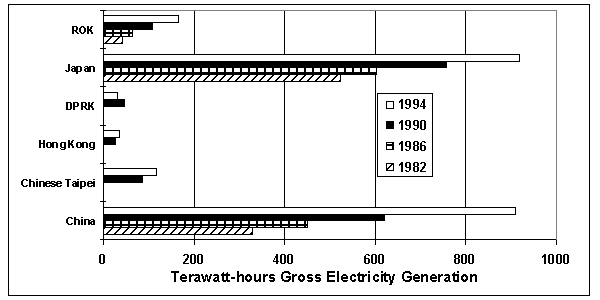
Table 1-1: Electricity Generating Capacity in Northeast Asia

Table 1-2 presents a comparison of projections of growth in electricity demand for some of the countries of the region, as compiled by several different groups of researchers. Though the projections shown reflect a range of opinion, the clear consensus is that growth in demand will be substantial, and the need for substantial additional generating capacity over the next 15 to 25 years is equally clear.
Table 1-2: Growth Estimates for Electricity Supply and Demand
in Three Northeast Asian Countries

- Analytical Approach
Our overall approach in estimating nuclear waste generation in the countries of Northeast Asia was as follows:
- We complied energy statistics for 1990 and 1995 for each of the countries studied, including data for electricity demand (by sector and subsector) and for electricity supply (by plant type and, in some countries, by plant).
- We used the compiled information as the "base year data" for development of scenarios of electricity demand for each country covering the period from 1990 to 2020. As a quantitative structure for these scenarios we used the LEAP (Long-range Energy Alternatives Planning) software package. The LEAP package allows the development of detailed end-use (demand) based energy scenarios across all fuels, as well as evaluation of the physical, economic, and environmental impacts of scenarios.
- We developed two different scenarios of nuclear power development in each country. The first, "base case" scenario generally reflects energy sector development in a way that continues recent trends. In the nuclear energy sector, the Base Case scenario typically includes primarily plants that are already under construction as of 1996, or are well into the planning phase. The second scenario for each country, a "Maximum Nuclear" scenario, reflects more aggressive development of nuclear power, typically consistent with higher-case estimates by groups such as the IAEA (International Atomic Energy Agency). The amount of electricity used in each country in each year is essentially the same in both the Base Case and Maximum Nuclear scenarios. In the Maximum Nuclear scenarios, the additions of non-nuclear generating capacity are reduced from Base Case values in such a way that the reserve margin (a measure of how much generation capacity is available above the level of peak power demand) is roughly the same in the two scenarios.
- We ran the models to generate estimates of electricity demand (by sector) and of electricity generation (by fuel and technology type) for each country for each year from 1990 to 2020.
- We applied waste generation factors (for low-level waste, spent fuel, Plutonium, Strontium-90, and Cesium-137) to the estimates of nuclear electricity generation by year and by technology to estimate the amounts of radioactive wastes, by country and by year, implied in each scenario.
- We estimated the impacts of nuclear fuel reprocessing options on generation of nuclear wastes, and the potential costs of "dry-cask" technology as a spent-fuel storage alternative.
In preparing energy-sector models and scenarios for each of the countries of Northeast Asia, we have built upon ongoing work in a Nautilus Institute Project entitled "East Asian Energy Futures", as well as the authors' ongoing analytical work on the the energy sector in the DPRK and other Nautilus projects.
- Plan of Remainder of Paper
The rest of this paper is organized as follows:
- Section 2
presents our "Base Case" (or "Business-as-Usual") and "Maximum Nuclear" generation capacity scenarios for each of the six countries (or regions, in the case of Hong Kong) modeled, including key input assumptions and scenario results (electricity demand and generating capacity over time).
- Section 3
presents our estimates for the quantities of nuclear wastes implied for each country under each of the two scenarios. The wastes considered include low-level nuclear waste, spent fuel and plutonium inventories, and estimated Strontium-90 and Cesium-137 production.
- Section 4
explores various options for storage, treatment, and/or recycling of spent nuclear fuel, including reprocessing and "dry cask storage".
- Section 5
presents our conclusions from this research, and our listing of some of the issues regarding nuclear power development and nuclear waste arrangements in Northeast Asia that deserve further study.
- Scenarios of Electricity Demand and Supply in Northeast Asia
We base our estimates of the production of nuclear wastes in Northeast on estimates of electricity production by type of generation for the period between 1990 and 2020. These estimates in turn are based on current patterns of electricity supply in each country, on assumptions as to the evolution of electricity generation infrastructure, and on growth in demand for electricity.
- Electricity Demand in Northeast Asia
Overall electricity demand for the six countries we modeled is based on sector level, and often sub-sector level, scenarios of demand for electricity. Although our Base Case estimates for electricity demand by country are not based on the work of any particular group, they are in many cases similar to those forwarded by other researchers. Key assumptions for our estimates of growth in electricity demand by country are presented in Annex A to this paper. The overall results of our electricity demand estimates are presented below for each of the countries modeled.
- Electricity demand in China
As shown in Table 2-1, industry will continue to be the dominant electricity consuming sector in China, but extremely rapid growth (7 to 8 percent per year) in electricity use in the residential and services sectors combine to make substantial inroads on that dominance by 2020.
Table 2-1: Electricity Demand in China by Sector, 1990 to 2020 (TWh)

Our electricity demand estimate for China roughly follows the trend of the USDOE/EIA International Energy Outlook projections, and is lower than a reference case projection assembled by the World Bank.
- Electricity demand in Chinese Taipei
As the economy of Chinese Taipei (Taiwan) continues to mature, the pattern of growth in electricity use in the country begins to resemble that of Japan. Table 2-2 shows growth in industrial electricity demand slowing, while growth in demand in the public and commercial sectors increases rapidly. Though industry used the majority of electricity in Chinese Taipei as of 1990, by 2020, according to our scenario, the industrial and public/commercial sectors will use similar fractions of national electricity supplies.
Table 2-2: Electricity Demand in Chinese Taipei by Sector, 1990 to 2020 (TWh)

- Electricity demand in the Democratic People's Republic of Korea (DPRK)
The DPRK presents a rather different picture of electricity demand from the other countries of the region. Due to a combination of adverse political, economic, and environmental circumstances, electricity demand in the DPRK decreased markedly between 1990 and 1996. Although our scenario for future electricity demand in the DPRK calls for a recovery in the DPRK economy, not until approximately 2003 does electricity demand rise back to 1990 levels. As shown in Table 2-3, the industrial sector uses the largest share of overall electricity demand through 2020, but growth in the residential, public/commercial, and transport sectors account for increasing proportions of demand over time.
Table 2-3: Electricity Demand in the DPRK by Sector, 1990 to 2020 (TWh)

- Electricity demand in Hong Kong
As in Japan, virtually all of the growth in electricity demand in Hong Kong is projected to come from the public/commercial/services sector, as industrial production continues to move elsewhere and as growth in residential electricity demand slows somewhat (see Table 2-4). Overall, electricity demand in Hong Kong in our scenario increases by an average of 5 percent per year from 1995 through 2020.
Table 2-4: Electricity Demand in Hong Kong by Sector, 1990 to 2020 (TWh)

- Electricity demand in Japan
Table 2-5 presents our projection of electricity demand in Japan, starting with statistics for 1990 and 1995 and going through the year 2020. Most of the growth in electricity demand in Japan in the next two-plus decades is projected to be in the commercial and services sectors, as structural change in Japanese industry (for example, the movement of heavy industrial production to sites in other countries) and a combination of higher-efficiency appliances and saturation of key electricity end-uses in Japanese residences combine to hold down growth in industrial and household electricity demand.
Table 2-5: Electricity Demand in Japan by Sector, 1990 to 2020 (TWh)

Our overall estimate for electricity demand growth in Japan is somewhat lower than USDOE/EIA International Energy Outlook projections, and is also somewhat lower than projections by the Institute of Energy Economics, Japan (IEEJ).
- Electricity demand in the Republic of Korea
Growth in electricity demand in the manufacturing sector of the Republic of Korea (ROK, or South Korea) is projected, in our scenario, to cool somewhat relative to its recent levels of increase, but growth in electricity demand in the services sector will be rapid, resulting in overall average growth in national electricity demand, as shown in Table 2-6, of 5.5 percent per year between 1995 and 2020.
Table 2-6: Electricity Demand in the Republic of Korea by Sector,
1990 to 2020 (TWh)

For the ROK, our estimate for electricity demand approximates the KEEI (Korea Energy Economics Institute) reference scenario, but is somewhat lower in later years.
- Aggregate regional growth in electricity demand
The major trend in the overall pattern of electricity demand by country in Northeast Asia, as shown in Figure 2-1, is the shift from Japan to China as the dominant consumer of electricity. Although Japan accounted for nearly half (48 percent) of the region's electricity use in 1990, in our scenario Japan consumes only 25 percent of region total demand by 2020, while the Chinese share of demand rises from 37 percent to 56 percent, and growth in electricity use in the ROK is even more robust.
Figure 2-1: Electricity Demand in the Northeast Asia, 1990 to 2020 (TWh)
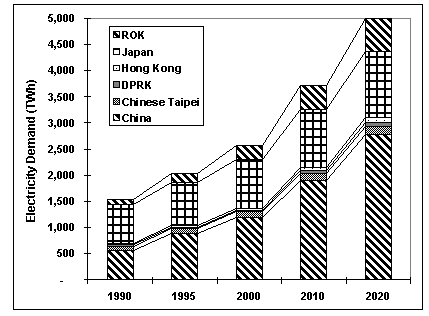
- Electricity Supply in Northeast Asia
We prepared two different scenarios of electricity supply for each of the countries of Northeast Asia. The first, which we call "Base Case" reflects a "business as usual" approach, and is basically a continuation of existing trends in capacity additions. For nuclear power, the Base Case scenarios for each country reflect mostly the addition of those plants described as "in the construction pipeline". Our "Maximum Nuclear" scenarios for several countries reflect IAEA (International Atomic Energy Agency) "High" estimates for growth of nuclear capacity. For other countries, our Maximum Nuclear scenarios represent our judgment as to the maximum practicable growth in nuclear power. In the remainder of this section we present our overall assumptions for the patterns of electricity supply by country from 1995 through 2020, as well as the trends in electricity generation and capacity resulting from each of the two scenarios.
- Electricity Supply in China
As electricity demand expands in China, coal (standard, washed coal, and FGD-equipped), oil, gas, hydro, and nuclear plants are added to maintain capacity factors and reserve margins at reasonable levels. In the Base Case, installed nuclear capacity rises from 2.17 GW in 1995 to 6.7 by 2003 with plants "in the construction pipeline" (as listed by USDOE EIA). Capacity rises to the EIA "Low" estimate of 18 GW in 2015, and 23 GW in 2020. Our Maximum Nuclear scenario follows and extends the IAEA "High" estimate, with installation of 8 GW of nuclear power in 2003, 12 GW by 2005, 21 GW by 2010, 38 GW by 2015, and 58 GW by 2020. The added nuclear capacity included in the Maximum Nuclear case mostly "backs off" (substitutes for) conventional coal-fired power, taking the place of some plants fired with washed coal and hydroelectric plants in later years. Electricity distribution losses are assumed to decline modestly between 1990 and 2010.
- Electricity Supply in Chinese Taipei
In the Base Case, as electricity demand increases, in Chinese Taipei, we assume that thermal generation fueled mostly with residual oil and coal will be brought on line, plus the two Lungmen nuclear units (1,250 MW each) that are in the construction pipeline. We manipulated the timing of capacity additions so as to maintain a reserve margin in the 20 to 25 percent range throughout the projection period. In the Maximum Nuclear case 3,750 MW of thermal generation capacity is phased out by 2018, and is replaced by new PWRs. An additional 3,750 of PWRs in the Maximum Nuclear case displaces generation provided by thermal power plants in the Base Case.
- Electricity Supply in the DPRK
Both of our electricity supply scenarios for the DPRK assume that modest additions to the generating base (including completion of coal-fired and hydroelectric plants under construction, and expansion of the existing oil-fired plant), plus rehabilitation of existing coal-fired and hydroelectric capacity, will take place between 1997 and 2005 as the DPRK economy begins to recover. We assume that the 2,000 MW reactors supplied by the Korean Peninsula Energy Development Organization (KEDO) will commence operation in about 2004, but that no other nuclear capacity will be built in the DPRK before 2020. We also assume that 90 percent of the electricity from the KEDO reactors will be exported-in our scenario, to the ROK. After 2005, in the Base Case, we assume that coal-fired generation capacity will expand to supply growing electricity demand, augmented by modest additions of oil-fired combined-cycle and new hydroelectric capacity. In the Maximum Nuclear scenario, an additional 5 GW of PWR capacity is assumed to be added in the DPRK by 2020, with the additional PWR capacity being offset by slower additions of new coal-fired plants.
For our Base Case scenario for Hong Kong, we assume that the scheduled expansion of the Black Point and Castle Point natural gas-fired plants will occur as scheduled by 2002, and that new coal steam, gas steam, and natural gas combined-cycle plants are added as necessary starting in 2008 so as to maintain a reserve margin in the 25-35% range (down from about 96% in 1990) for the projection period. Nuclear power for Hong Kong in the Base case comes only from the fraction of existing Chinese (mainland) PWR now under contract. In the Maximum Nuclear case, we assume that 3,000 MW of additional Chinese nuclear capacity is purchased for use by Hong Kong during the 2006 to 2018 time frame.
- Electricity Supply in Japan
In the Base Case, we assume that new nuclear plants will be phased in as per USDOE EIA "Low" estimates for timing of units "in the construction pipeline", and that existing nuclear plants will be phased out as they reach 40 years old. We add capacity over time (some pumped-storage, standard coal-steam plants, natural gas steam plants, natural gas and oil combined-cycles plants) so as to maintain a reserve margin in the 25% range (down from about 39% in 1990) for the projection period.
In the Maximum Nuclear case, we assume that the timing of plants added in the next 15 or so years conforms to the "High" category of the DOE/EIA "plants in the construction pipeline" listing, plus additional nuclear generation to raise total nuclear capacity to 60 GW by 2010, and to 80 GW by 2020. Existing coal and oil plants are retired starting in 2000, and less new coal- and oil-fired capacity built is built than in the Base Case scenario. Please see the "Results" section below for a listing of plant capacities added by plant type.
- Electricity Supply in the Republic of Korea
In the Base Case, most additional generation capacity additions in the ROK are assumed to be coal-fired steam-cycle or natural gas-fired combined-cycle plants, in roughly equal proportions. The pattern of additions of nuclear generating capacity is similar to the USDOE/EIA "Low" case, in which nuclear capacity rises slowly until 2008, remaining flat until about 2013 (17GW), then rising slowly again to about 19 GW (total) by 2020. In the Maximum Nuclear case, our assumption is that nuclear capacity additions will follow the IAEA "High" scenario, rising to approximately 36 GW by 2020, with the increased nuclear capacity (relative to the Base Case) offsetting coal-fired power plants.
- Electric generating capacity in Northeast Asia, 1990 to 2020
Table 2-7 highlights the overall differences, on a regional basis, between our Base Case and Maximum Nuclear scenarios. By 2020, there are about 110 GW more of regional nuclear capacity in the Maximum Nuclear scenario than in the Base Case, with almost all of the additional 110 GW of nuclear taking the place of thermal (mostly coal-fired) power stations. Figure 2-2 provides a comparison of the fraction of total generating capacity in 1995 and in 2020 that is made up by nuclear capacity under the two cases. Overall, in every country but China and the DPRK, the share of nuclear power decreases between 1995 in the Base Case scenario. In the Maximum nuclear case, the share of nuclear power is higher in 2020 than in 1995 in each country, reaching 40 percent in Chinese Taipei, 29 percent in Japan and the ROK, and 31 percent in the DPRK. Figure 2-3 shows the changes in the fraction of regional nuclear generating capacity over time in each scenario. Overall, the distribution of nuclear capacity between the major users of nuclear power in the region is not much different in the two scenarios, the major difference being that China's share of the region's nuclear plants is somewhat higher (30 percent versus 25 percent) in the Maximum Nuclear scenario, and the shares of the ROK and Chinese Taipei are somewhat lower.
Table 2-7: Aggregate Northeast Asia Electric Generating Capacity
Under Two Scenarios, 1990 to 2020 (GW)
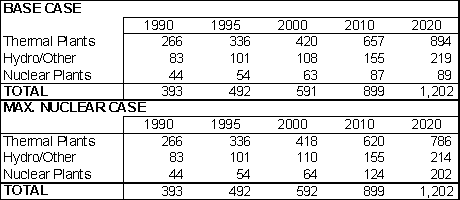
Figure 2-2: Nuclear Generating Capacity as a Fraction of Total Capacity in
Northeast Asia Under Two Scenarios, 1990 to 2020
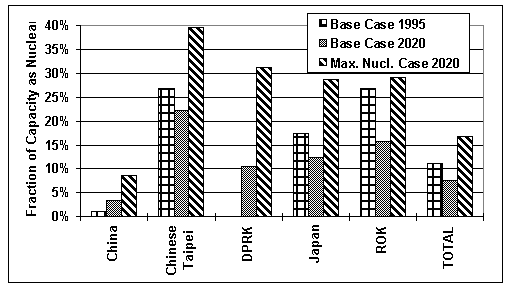
Figure 2-3: Shares of Regional Nuclear Capacity by Country
Under Two Scenarios, 1990 to 2020
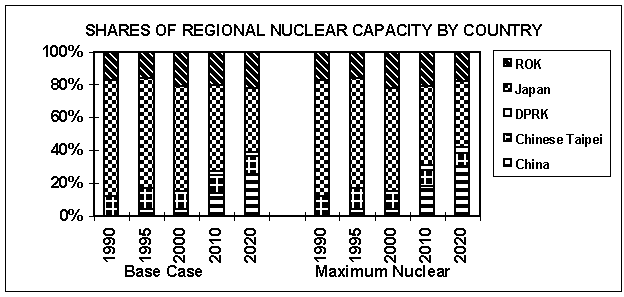
Table 2-8 provides a breakdown of generating capacity by type and by year in each country for the Base Case and Maximum Nuclear scenarios. A similar table listing annual generation by plant type (which generally follows similar patterns to generation) is provided as part of Annex A to this paper.
Table 2-8: Northeast Asia Electric Generating Capacity by Country
Under Two Scenarios, 1990 to 2020 (GW)
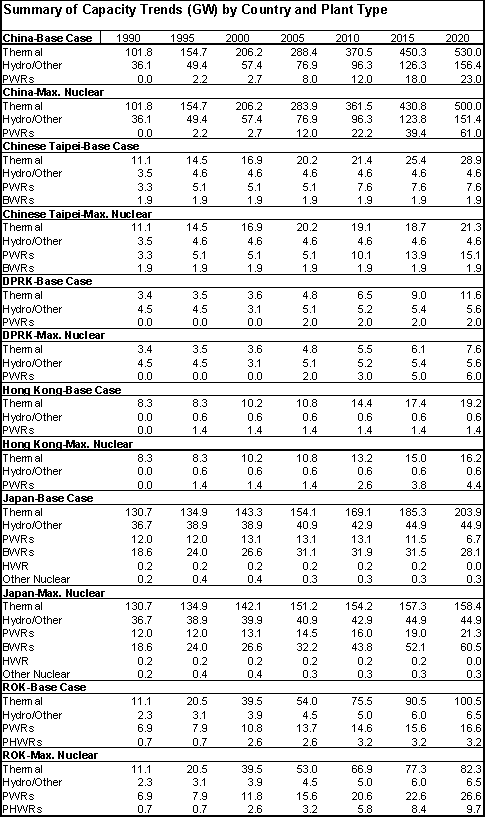
- Estimates of Nuclear Waste Generation in Northeast Asia
Based on the results of the scenarios for electricity generation described above, we prepared estimated of the amounts of several different classes of nuclear wastes that will be produced as a result of routine nuclear plant operations between 1990 and 2020. These estimates were prepared by applying various waste generation factors to annual electricity generation by reactor type and by country. Below we describe our general assumptions in carrying out these calculations, and present the results of our analyses.
- Nuclear Waste Generation During Routine Reactor Operation
We have attempted to estimate the generation of nuclear wastes in several different categories:
- Low-level wastes
- Spent fuel
- Plutonium in spent fuel
- Strontium-90 and Cesium-137 in spent fuel
- Wastes that would be produced during reprocessing of spent fuel.
Our assumptions and results for wastes of each of these types are presented below. Note that these are intended to be rough estimates only, as waste generation differs somewhat by the make, model, and vintage of reactor (even within the same general reactor type) as well as by the ways in which refueling of reactors and plant maintenance is carried out. Results on a country-by-country basis can be found in Annex B to this paper. Note that our estimates for nuclear waste generation do not include wastes from other than civilian nuclear power, waste inventories generated previous to 1990, or wastes that will be produced after 2020 by the power reactors included in our scenarios.
- Low-level waste production
Low-level wastes are produced during routine reactor operations, and though they are usually contain relatively little radioactivity per cubic meter, they often are relatively large in aggregate volume, which makes their disposal difficult. Low-level wastes include machinery, gloves, aprons, paper, resins, and other materials contaminated with radioactive materials. Low-level wastes generally average less than one curie per cubic foot (35 curies per cubic meter). Our estimates of generation of low-level wastes start with assumptions, as presented in Table 3-1 about the range of waste production per unit of electricity generated.
Table 3-1: Range of Low-level Radioactive Waste Production
per TWh of Electricity Generated
,

Table 3-2 presents our range of estimates of low-level radioactive waste generation, for the Northeast Asia region as a whole, under our Base Case and Maximum Nuclear scenarios. In each case, low-level waste generation in Japan accounts for well over half of the regional total generation from 1990 to 2020, principally because the Japanese civilian nuclear program is currently both larger and more advanced than programs in other countries. To place the volumes of waste estimated in Table 3-2 in perspective, consider that cumulative regional low-level waste generated in Northeast Asia between 1990 and 2020 would be sufficient to bury a road 10 meters wide and 150 to 300 km long (most of the length of South Korea) to a depth of one meter.
Table 3-2: Estimated Range of Low-level Radioactive Waste Production
(Volume and Radioactivity) for Northeast Asia, 1990 to 2020
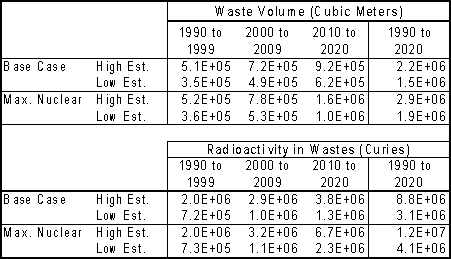
- Production of spent fuel, Plutonium, Strontium-90, and Cesium-137
Our estimates of the total mass of heavy metals in spent reactor fuel, of plutonium in reactor fuel, and of the amount (in Curies) of the biologically-important radioactive isotopes Strontium-90 and Cesium-137 contained in spent fuel are based on the rule-of-thumb assumptions presented in Table 3-3.
Table 3-3: Assumptions Used in Preparing Estimates of Production of Spent Fuel, Plutonium, Strontium-90 and Cesium-137
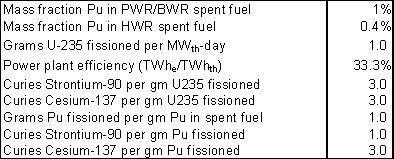
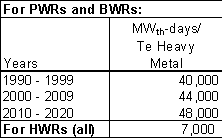
As shown in Table 3-4, our estimates imply total production of approximately 51,000 (Base Case) to 72,000 tonnes of spent fuel from civilian nuclear reactors in Northeast Asia between 1990 and 2020. In both cases, spent fuel production increases in the later years of the projection period (as more reactors come on line). This increase is particularly pronounced in the Maximum Nuclear scenario, where production of spent fuel from 2010 to 2020 is more than double than in the preceding decade. Production of plutonium follow a similar pattern, with about 450 (Base Case) and 620 (Maximum Nuclear case) tonnes produced in spent fuel between 1990 and 2020.
Table 3-5 presents our estimates of the production of Strontium-90 and Cesium-137 in spent nuclear fuel in Northeast Asia between 1990 and 2020. By 2020, between 6 and 10 billion Curies of each isotope will have been produced. Note that fission products such as these isotopes of strontium and cesium can come either from the fission of one of the uranium atoms originally present in the reactor fuel, or from the fission of a plutonium atom created within the fuel during reactor operation. These two pathways for the generation of fission products are shown schematically in Figure 3-1.
Table 3-4: Estimates of Production of Spent Fuel, and Plutonium in Spent Fuel,
in Northeast Asia: 1990 to 2020

Table 3-5: Estimates of the Production of Strontium-90 and Cesium-137
in Spent Fuel in Northeast Asia: 1990 to 2020
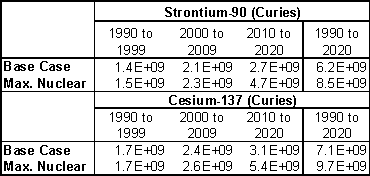
Figure 3-1: Pathways for Generation of Nuclear Fission Products
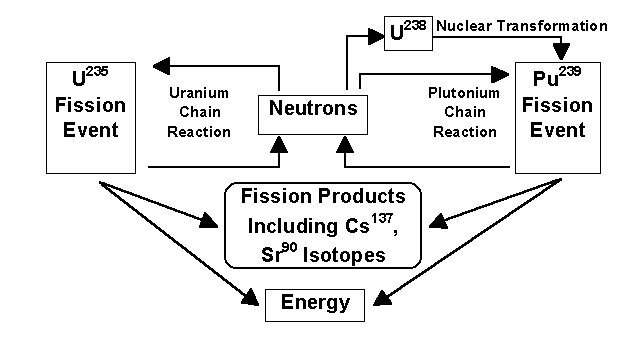
- Potential Generation of Nuclear Wastes from Reprocessing of Spent Fuel
The plutonium and/or uranium in spent fuel from nuclear reactors can be "reprocessed" by separating the heavy metals from the spent fuel, concentrating the fissionable elements, fabricating the recycled nuclear materials into fuel pellets, and building the pellets into fuel rods for use in reactors. The concept of reprocessing is a controversial one, in large part (but not exclusively) because of the wastes that are created during reprocessing and because of the potentially enhanced potential for diversion of nuclear materials under a reprocessing regime. Although there are active reprocessing plants in Europe, and Japan has seriously debated establishing reprocessing facilities of its own for some years, there are as yet no large-scale fuel reprocessing facilities in Asia.
There are several different types of nuclear fuel cycles including fuel reprocessing that can be pursued, and there are many different points of view on which (if any) might be the most likely to ultimately be used in Northeast Asia. As an illustrative exercise, we estimated what the nuclear waste implications would be of reprocessing half of the spent fuel generated in Northeast Asia. For this exercise, we assumed that only uranium from spent fuel would be re-used, although (as noted) many other fuel cycles are possible and have been touted. The general assumptions that we used in preparing our estimate of reprocessing wastes are provided in Table 3-6.
Table 3-6: Assumptions for Estimates of Quantities of Nuclear Wastes
from Reprocessing of Spent Fuel
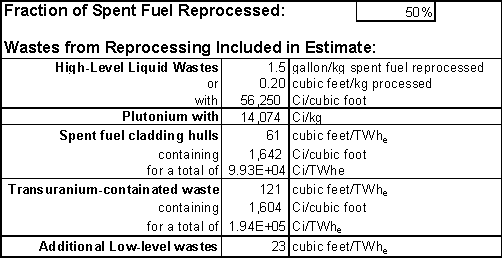
Using the assumptions above, we derived the mass/volume and radioactivity estimates for production of high-level liquid wastes, plutonium, fuel cladding hulls, transuranic wastes, and low-level wastes from reprocessing of spent fuel in Northeast Asia. These estimates are presented in Table 3-7a and b, below.
Table 3-7a: Estimates of Quantities of Nuclear Wastes
from Reprocessing of Spent Fuel in Northeast Asia, 1990 to 2020
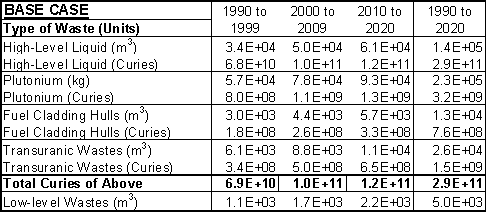
Table 3-7b: Estimates of Quantities of Nuclear Wastes
from Reprocessing of Spent Fuel in Northeast Asia, 1990 to 2020
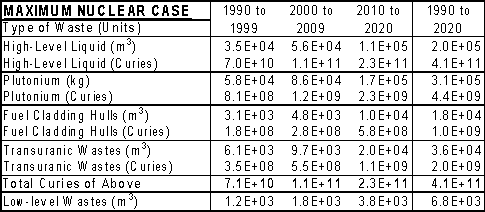
- Estimates of Requirements and Costs for "Dry Cask Storage" of Spent Fuel
Spent nuclear fuel contains long-lived radioisotopes, and thus poses a sufficient radiological and toxic hazard that must be isolated (from humans and from the ecosystem) virtually indefinitely. Progress on siting permanent storage facilities for spent nuclear fuel and other high-level nuclear waste has been slow-both in the United States and in other countries. Meanwhile, the inventory of spent nuclear fuel stored in "spent fuel pools" (literally below-ground pools of water) at reactor sites has been increasing in Northeast Asia and elsewhere. Recently, the concept of "dry cask storage" of spent nuclear fuel has generated considerable interest as a possibility for at least interim storage and isolation of nuclear materials. In dry cask storage, spent nuclear fuel is cooled in spent fuel pools for at least five years after it is removed from the reactor. The cooled fuel rods, still in their fuel assemblies, are then loaded into specially-designed stainless steel tubes within a storage (or multi-purpose storage/transport) cask, water is pumped out of the cask, and the cask is filled with an inert gas and welded shut. Several different designs for casks exist (and are sized for different types of fuel assemblies), but all are both large and massive. Most casks designs currently contemplated are cylinders, with typical units measuring on the order of 1.25 to 1.5 meters in diameter by and slightly less than 5 meters in height. The casks consist of a thick (2.5 to tens of centimeters or more) steel or iron shell, often augmented by a surrounding wall of concrete and other materials. Full, these casks weigh on the order of 100 tonnes. Some casks, such as the "Multi-Purpose Canister" are designed so that they can be stored at a reactor site (for example, within a concrete vault or in more massive concrete sleeves), transported (within special transport casks) via road or rail, and placed in interim or permanent off-site storage facilities, all without opening the casks.
Given that permanent storage facilities for spent nuclear fuel are highly likely to be unavailable for decades (if not longer) in most locations, dry cask storage appears to offer a relatively inexpensive, safe, reliable, and expedient means of indefinitely storing spent fuel. Starting with our estimates of the quantities of spent fuel that may be produced in Northeast Asia between 1990 and 2020, we estimated the costs of and area required for dry cask storage of spent fuel. The assumptions we used, and the results of our calculations, are presented below.
- Estimates of Requirements and Costs for Dry Cask Storage of Spent Fuel: Assumptions
The assumptions that we used in estimating the requirements for dry cask storage of spent nuclear fuel in Northeast Asia are presented in Table 4-1.
Table 4-1: Assumptions Used to Estimate Requirements for and Costs of Dry Cask Storage of Nuclear Spent Fuel

The sources of the assumptions shown above are referenced in detail in Annex B to this report. Most of the assumptions shown are based on a 1994 US DOE Office of Civilian Radioactive Waste Management (US DOE OCRWM) document entitled Multi-Purpose Canister System Evaluation (see endnotes for full reference). Our estimate of the amount of storage area required per cask assumes that casks are placed on a concrete pad in a 4 by 5 meter grid, as is (roughly) the case with at least one operating installation, but many other storage configurations are possible. For operating and maintenance costs, we used "mid-range" estimates for "independent spent fuel storage installations" using dry cask storage from a document prepared for OCRWM. Operating and maintenance costs-including site security, operations personnel, overhead, consumables, utilities, insurance, and licensing fees-are largely independent of the number of casks stored. Analysis presented in the Multi-Purpose Canister System Evaluation document referenced above, indicates that the costs of indefinite operation of dry cask storage systems are lower (probably far lower) than the costs of indefinitely operating spent fuel pools at reactor sites.
Table 4-2 presents our estimate of the implied number of storage casks, cask storage area, and costs for storing the spent fuel generated during the lifetime (assumed to be 40 years) of a 1000 MW (electric) LWR (light water reactor-either a pressurized water reactor or boiling water reactor). We estimate that about 80 storage casks will be required to store the spent fuel generated during the reactor's lifetime, and that these casks will occupy a storage area equal to about one-sixth of a hectare-about half the size of a football field. The present-value costs of dry cask storage, when averaged over the total lifetime output of the reactor, amount to only about 0.11 mills (thousandths of a dollar) per kilowatt-hour generated. This represents only on the order of one percent of the total cost of nuclear generation.
Table 4-2: Estimate of Dry Cask Storage Requirements for a 1000 MW LWR
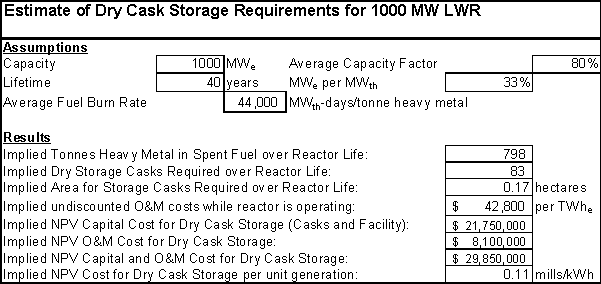
- Estimates of Dry Cask Storage Requirements in Northeast Asia
We estimate, under our Base Case scenario, that approximately 5,300 dry storage casks will be required to store spent reactor fuel used in Northeast Asia between 1990 and 2020, compared with 7,5000 needed under the Maximum Nuclear scenario (Table 4-3). These casks will require a relatively modest (on a regional scale) 11 to 15 hectares of storage space at reactor sites (or other off-reactor storage site). Table 4-4 presents our estimates of the cask volumes and (undiscounted) capital/O&M costs for dry cask storage under the two scenarios. Although the regional total costs for storage amount to a seemingly-impressive 2.5 to 3.5 billion US dollars over 1990 to 2020, it should be remembered that this total is trivial compared to the capital costs of the reactors themselves, which in aggregate will run to hundreds of billions of dollars for the region. Not yet factored in to this calculus, as noted above, are the costs for maintaining spent fuel in spent fuel pools at reactor sites that are avoided by the use of dry cask storage. When these and other avoided costs are appropriately included, it is probable that the net costs of dry cask storage systems relative to alternative waste isolation approaches will prove to be minimal (or even negative).
Table 4-3: Estimate of Number of Casks and Area Required for
Dry Cask Storage of Nuclear Spent Fuel in Northeast Asia, 1990 to 2020
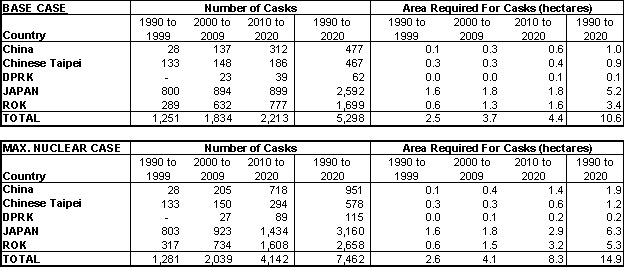
Table 4-4: Estimate of Cask Volume and Cost for Dry Cask Storage of Nuclear Spent Fuel in Northeast Asia, 1990 to 2020
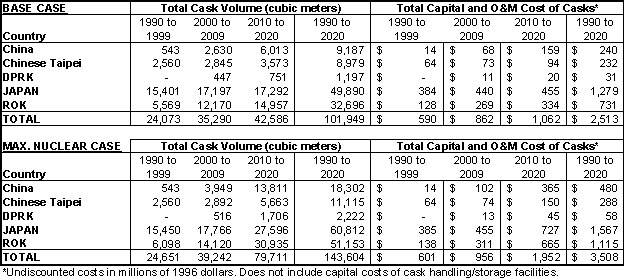
- Conclusions and Issues for Further Study
- Conclusions
Some general conclusions from our work are as follows:
- Growth in electricity demand in Northeast Asia over the next two-plus decades will be enormous if current economic trends continue. On the order of 700 GW of generating capacity will have to be built between 1995 and 2020, although aggressive programs to increase the efficiency of electricity end-uses might be able to reduce the required capacity to some degree.
- In our Base Case scenario, the fraction of capacity provided by nuclear power in the countries of Northeast Asia decreases on a regional basis and in each country except China (which has just started its nuclear program) and the DPRK (which has no operating reactors at this time). In the Maximum Nuclear scenario, nuclear power's share of total regional capacity increases from 11 percent in 1995 to 17 percent in 2020.
- Under the Base Case scenario, the total nuclear capacity in the six countries we have modeled will be 89 GW by 2020. In the Maximum Nuclear case it is more than twice as high, at 202 GW.
- Under either scenario, significant quantities of nuclear wastes will be produced. Between 1990 and 2020, approximately 50 to 70 thousand tonnes of spent fuel containing 450 to 620 tonnes of plutonium will have been generated. These figures, of course, do not count the wastes that will be produced over the remainder of the lifetime of the reactors installed during 1990 to 2020, which will be-particularly in the case of the Maximum Nuclear scenario-considerable.
- Dry cask systems for medium and long-term storage of spent nuclear fuel at reactor sites seems to be an attractive, affordable option for handling at least some of the radioactive by-products of nuclear power generation. Though dry cask storage does not render spent fuel completely inaccessible (with the right equipment, casks can be opened, and fuel removed), it keeps fuel handling and transport to a minimum, and makes storage locations relatively easy to safeguard.
- Independent of the systems for waste isolation (or recycling) chosen, the quantities of nuclear materials implied in either the Base Case or Maximum Nuclear scenario will require some sort of regional cooperation on nuclear fuel and nuclear waste technologies, handling protocols, and planning. Some of the issues associated with regional cooperation on nuclear matters are discussed below.
- Issues for Further Study
As is noted in earlier sections, Japan and South Korea are already major users of nuclear power, China is starting a nuclear program, and North Korea is scheduled to receive 2 GWe of nuclear capacity as a part of the Agreed Framework. As the ROK will play a major role in providing equipment for and constructing the nuclear plants in the DPRK, nuclear cooperation between those countries, at least as far as plant assembly and (probably) operation, is a given.
The issue of how to manage the various categories of nuclear waste arising from the operation of nuclear reactors, however, has not been settled in a satisfactory way in any of the countries of the region. Proposals have been made for an "Asiatom" or a "PacificAtom"-a cooperative regional organization designed to coordinate nuclear activities in the countries of the region (and possibly, in the more distant future, found and manage a regional waste repository). Even short of such a formal regional organization, the ROK and Japan have expertise and technology in techniques for handling of nuclear materials that could be made available to assist the nuclear programs of other countries in the region.
As with nuclear power, spent fuel managers face a set of common challenges whether spent fuel is stored on a national or a regional basis. However, centralized, regional spent fuel management would have to surmount an additional series of obstacles to succeed. These latter factors-any one of which could make implementation of such a scheme impossible--are outlined briefly in the following sections.
- Technical Issues Regarding Nuclear Waste Management
A number of states in East Asia-most notably Taiwan and South Korea-argue that within a few years, they must either send spent fuel offshore for reprocessing and interim storage, or find some other solution to interim storage of reactor spent fuel. This argument follows from the fact that spent fuel ponds are now crowded and nearly full, even with increased density of racking. The disposition and treatment of spent fuel is linked closely to desires to extract plutonium and recycle it as mixed oxide fuel in light water reactors or as start up fuel for the breeder reactor in Japan. This goal is also sought in order to circumvent domestic opposition to national spent fuel storage by shipping it to a regional repository, to simply to preserve the option of a plutonium-based nuclear fuel strategy in the future.
However, it is not evident why dispersed, national interim spent fuel storage--either at a national facility (such as that planned for Japan) or on existing reactor sites--would not be the best technical solution for the few decades. This "distributed" solution minimizes transport and diversion-related hazards, and may be less susceptible to wartime and seismic threats as well as cheaper than regional, centralized spent fuel storage. Above all, building such local facilities at reactor sites using dry casks would be highly visible and might force local and national communities to address the issue of wisdom of producing more spent fuel until a long term disposal technology becomes available.
- Institutional Issues Associated With Waste Management Regimes
The most intractable difficulties which would arise with a regional spent fuel storage system would likely be not technical, but political and institutional in nature. It is not obvious what would be a non-controversial membership or what boundary of "regional" would best serve such a system. China and South Korea could be expected to block Taiwan and North Korean membership, respectively. An "Asia" or "Asia Pacific" region which spanned North and Southeast Asia and possibly South Asia would not correspond to any existing regional entity, and the various states with nuclear spent fuel problems to solve have widely varying technical capabilities, nuclear weapons status, and political power. They range from nuclear armed superpowers (Russia, United States), to nuclear armed great power (China) to near nuclear (India and Pakistan) to nuclear powered but nuclear free (Japan, South Korea) great or medium-sized state, to nuclear powered and isolated medium sized state (Taiwan), to nuclear weapons aspirant but nuclear free (North Korea) to non-nuclear but candidate state for spent fuel storage (Australia). It is certain that the host for a regional spent fuel facility would have to be an existing and declared nuclear weapons state-which boils down to China and Russia as candidates. The former has a major problem of mistrust with many of the potential participating states, while the latter has a legal constraint on spent fuel imports.
Even if these hosting and membership issues could be solved, many practical institutional issues would have to be addressed, including the ownership and control of special nuclear materials in or separated from the spent fuel stored in a regional repository, the transparency of the physical flows and accounting for national shipments to and from such a facility, the potentially infinite longevity of such a facility should it prove impossible to return all the wastes to states of origin, and the specific timing of attempts to create such an arrangement given all the other regional geopolitical, geoeconomic, and even geopolitical issues which could have priority over proposals for centralized, regional spent fuel storage. These latter factors are developed more fully in section 5.2.8.
The costs of interim spent fuel storage, whether for a centralized, regional facility or for dispersed, national facilities, are relatively small, both absolutely, and as a fraction of the cost of electricity generated by nuclear reactors. However, the distribution of costs and benefits of interim spent fuel storage will play an important role in determining the political feasibility of any
such scheme, regardless of whether it is a centralized regional or a dispersed national approach. In reality, the only scheme for a regional, centralized repository which is likely to be feasible given the intense political concerns surrounding nuclear fuel cycle issues in this region is a market-based commercial scheme employing primarily private funds.
China is the only state in the region that could legally and politically pursue such an approach, but lacks the public or private financing ability to create such a facility. Thus, China's capability would be dependent on an external financier coming forth, which in turn would be subject to the interplay of much larger geopolitical and geoeconomic issues relating to China's role in the region.
At the national level, the distribution of costs and benefits has also proven to be a crucial issue in South Korea and in Japan in obtaining political legitimacy for spent fuel storage and reprocessing facilities (the Rakkasho facility may become a national interim spent fuel site for Japan, pending the resolution of legal and financing issues between Tokyo and the local community).
What seems clear is that commercial interests will predominate in the long-run development of interim spent fuel sites as the electricity utility sector is deregulated in Japan and South Korea (which will accelerate under the new IMF-directed economic policies in South Korea). As Frans Berkhout notes, all the effective multinational nuclear waste management schemes in recent decades have arisen from trade in nuclear fuel services, not from government-led initiatives.
- Security impacts of Different Nuclear Fuel Cycle Futures
The location and centralization/dispersion of stored spent fuel has important implications for the possibility for terrorist attacks and seizure of fissile materials; for the clandestine diversion of fissile materials by governments in the region; for wartime missile or aerial attack; and depending on the monitoring and verification aspects of interim spent fuel storage, on the confidence in the global and regional nuclear non proliferation regimes. Each of these factors bears close examination when comparing the desirability of regional, centralized repositories versus national, dispersed facilities.
Of particular importance is the relationship between regional spent fuel storage and the plutonium economy. If the regional option is adopted in order to preserve or to facilitate plutonium recycling in light water reactors, or breeder reactor programs as in Japan, then the differential risk/benefit ratios of the regional-centralized versus national-dispersed approaches may shift dramatically in relation to these security criteria.
Some have argued that even though a regional repository may be impossible to realize, a dialogue to examine its feasibility and desirability may itself generate mutual understanding and confidence. However, it is not true that dialogue always generates understanding and confidence. We argue that unless the underlying assumptions are explored and the empirical and technical validity and soundness of concepts are examined collaboratively, such a dialogue may lead to diversionary debates with respect to the real issues involved with realizing regional and global energy security, and could even destroy rather than build confidence in the region between already suspicious past and present adversaries.
- Potential Legal Obstacles To Nuclear Development In Northeast Asia
Although the market will likely militate against regional and increasingly national government-led interim spent fuel arrangements linked to reprocessing, any regional scheme faces legal obstacles, any one of which could prove impossible to surmount. These include: US and uranium supplier bilateral agreements controlling the disposition of spent fuel from light water reactors in Japan, South Korea, and Taiwan; domestic laws concerning the disposition of spent fuel at the time of reactor licensing; and Russian laws against importing foreign nuclear wastes. In addition, certain national legal and political commitments such as the Korean Denuclearization Declaration would make it difficult if not impossible for some parties such as North and South Korea to join in schemes which revolve around offshore regional reprocessing and/or mixed oxide recycling.
- The Role Of Transparency In Nuclear Power Development
Decision-making in relation to national and utility level commitments to nuclear power and fuel cycle operations is becoming increasingly transparent in two respects.
First, the slow but steady democratization of the polities of the region and the emergence of vibrant civil society and non-governmental organizations has increased the pressure on governments and fuel cycle agencies to open their books, both with respect to subsidies and financing arrangements linking nuclear power to the public purse; and to the safe, accountable operation of facilities. This trend has been most pronounced in Japan and South Korea, and tends to reduce the likelihood of regional arrangements. Indeed, such schemes may be confidence destroying rather than confidence building as proved to be the case with the Taiwan-North Korea low level waste deal as it unravels in the face of intense opposition emanating from South Korean anti-nuclear organizations such as Green Korea.
Second, a much higher level of transparency with respect to long-run energy and nuclear energy planning is likely a precondition to any intergovernmental agreement to create a regional spent fuel storage scheme. Most of the official projections of nuclear power are highly optimistic. Consequently, these projections overstate the likely quantities and therefore the need for spent fuel repositories. A realistic and consensual basis for analyzing the cost-benefit ratio of such schemes would be an essential preliminary activity in exploring regional spent fuel options , assuming that the political issues arising from transparency referred to in the previous section could be overcome.
- Environmental issues
A regional facility will be subject to review from many quarters on environmental grounds in terms of the risks and benefits of prospective siting and related transport of spent fuel and/or plutonium to and from the site; and to the extent that such a facility could hold the key to the long-run survival of the nuclear fuel cycle by preserving the plutonium option-an argument now made in particular by some Japanese proponents-it will be reviewed also with regard to the putative positive impacts of nuclear power on a range of local, regional (acid rain), and global (greenhouse gas) emissions-both in terms of direct avoidance of these damaging emissions, and in terms of the opportunity cost of foregone emissions-avoided if the requisite nuclear-related investments had been directed toward alternative and likely cheaper ways to achieve the same ends. In addition, liability and insurance issues arising from a centralized, regional spent fuel storage and transport system will have to be addressed, especially in relation to trans-boundary movements and possible impacts from accidental releases of nuclear materials.
- Political Aspects
In any regional spent fuel repository, the symmetries and a-symmetries of capabilities and influence will be crucial to success or failure. In particular, the perceived legitimacy of the leading states and interested parties involved in such a scheme will determine whether such a scheme could even get off the ground, let alone succeed. Given the enormous variation in scale, fuel cycle capabilities, energy needs, social systems, and economies-not mention the role of civil society-among and within the potential member states, it is dubious whether such a scheme is viable.
One thing is crystal clear after fifty years of nuclear fuel cycle development in the region. Public opinion now affects public policy and political decisions relating to the nuclear fuel cycle in every state in the region. Public opinion-and its increasingly trans-national determinants--cannot be ignored or merely managed as a public relations problem for regional spent fuel repositories. Rather, unless there is strong public support in each and every participating and affected state, such schemes are likely to generate more political heat than useful energy, and to destroy rather than to build confidence. In our view, the onus to prove otherwise rests heavily on the proponents of such schemes.
6. Endnotes
The Nautilus Institute for Security and Sustainable Development
125 University Avenue, Berkeley, CA 94710-1616 USA
(510) 204-9296 * Fax (510) 204-9298 * Web: http://www.nautilus.org
Return to top |
Energy Futures |
Energy Home



























